
Today’s breakdown features a clash between right and wrong, with Donald Duck!
Donald’s Better Self wasn’t originally intended as a Donald Duck cartoon; instead, its was slated to be a Silly Symphony. In 1934, Eleanor Roosevelt brought the story of “Streubel Peter,” based on Heinrich Hoffman’s Der Struwwelpeter, to Walt’s attention. Translated into Slovenly Peter in 1891 by Mark Twain, the story involved an unruly boy who torments barnyard animals for his amusement, and then has a dream in which they take revenge on him. The Silly Symphony never made it past the story stage, since the studio couldn’t make the character sympathetic. Story artist Ferdinand Horvath, who contributed various concept sketches of the film, stated this idea evolved into the Donald Duck cartoon, initially titled “Good and Evil” (which is indicated on the draft.)
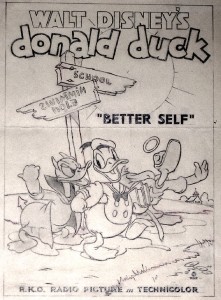 Director Jack King arrived back at the Disney studio on April 27, 1936 to direct the new series of Donald Duck cartoons. He previously left Warner Bros. after directing several black-and-white Looney Tunes with Buddy, Beans the Cat and Porky Pig. King had already worked for Disney, and was one of the first East Coast animators Walt hired around June 1929. Before Disney, King worked at Bray Studios and on Bill Nolan’s Krazy Kat cartoons.
Director Jack King arrived back at the Disney studio on April 27, 1936 to direct the new series of Donald Duck cartoons. He previously left Warner Bros. after directing several black-and-white Looney Tunes with Buddy, Beans the Cat and Porky Pig. King had already worked for Disney, and was one of the first East Coast animators Walt hired around June 1929. Before Disney, King worked at Bray Studios and on Bill Nolan’s Krazy Kat cartoons.
Studio records indicate that King directed one Mickey Mouse at Disney’s during this period, The Haunted House (1929). He also drew on the Floyd Gottfredson’s Mickey Mouse comic strip for two weeks, from June 9-21, 1930. After animating on several Mickey Mouse and Silly Symphonies cartoons, he left Disney’s by early 1933.
King largely casts his animators by sequence in Donald’s Better Self; Don Towsley animates the entire opening sequence, introducing Donald’s “selves” as he/they prepare for school. Towsley’s drawing/animation is dynamic, and often uses difficult angles on the head and body, which seem almost effortless. Paul Allen animates Donald being sidetracked to go fishing with his Evil Self (voiced by Don Brodie). He handles his Good Self (voiced by Thelma Boardman) confronting Donald near the end of the film. Allen tends to draw their heads slightly ‘pinched,’ not quite as rounded as the other animators.
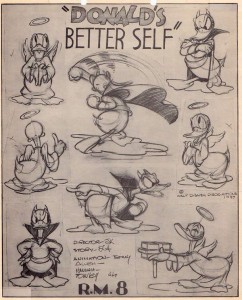 Berny Wolf handles an extensive sequence— lasting almost three minutes— where the Evil Self forces Donald to smoke a pipe, including his attempts which make him sick. Concept sketches by Ferdinand Horvath from the original Struebel Peter idea show Peter smoking a pipe, which could allude to the development of the Donald Duck cartoon. While the film was in production, the studio was in its early stages on Pinocchio; it bears similarities to the film, as Donald innocently puffs on the pipe, while his Evil Self urges him to “take a real drag.” This might have served as a conscious story idea in the possibilities for a smoking sequence in Pinocchio; story meetings taken in February 1938 expanded upon them, a month before Donald’s Better Self was released.
Berny Wolf handles an extensive sequence— lasting almost three minutes— where the Evil Self forces Donald to smoke a pipe, including his attempts which make him sick. Concept sketches by Ferdinand Horvath from the original Struebel Peter idea show Peter smoking a pipe, which could allude to the development of the Donald Duck cartoon. While the film was in production, the studio was in its early stages on Pinocchio; it bears similarities to the film, as Donald innocently puffs on the pipe, while his Evil Self urges him to “take a real drag.” This might have served as a conscious story idea in the possibilities for a smoking sequence in Pinocchio; story meetings taken in February 1938 expanded upon them, a month before Donald’s Better Self was released.
Jack Hannah, later a story artist and director on several Donald Duck entries, handles Donald’s Good Self berating his Evil Self, leading up to the first half of their fight, after the Good Self emerges from a lake. Hannah also handles the final sequence of Donald and his Good Self marching toward the schoolhouse. Chuck Couch animates the last half of the fight sequence, where Donald’s Good Self power-dives into the Evil Self, sending him underground (back where he belongs, perhaps?) Ed Love is assigned two reaction shots with Donald, interestingly giving Donald a change of heart; in scene 54A, he takes joy in his Evil Self tormenting the other, and in sc. 68A, Donald is cheering for his Good Self during the fight.
The story outline for Donald’s Better Self was approved on January 16, 1937; its story directors were Tom Armstrong, Carl Barks, and Harry Reeves. The draft indicates it was approved on May 10. The film was released several months later, on March 11, 1938. It also played at the Radio City Music Hall on July 7-13 with Alfred Santell’s Having Wonderful Time, starring Ginger Rogers and Douglas Fairbanks, Jr.
Enjoy this breakdown video!
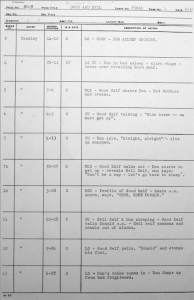




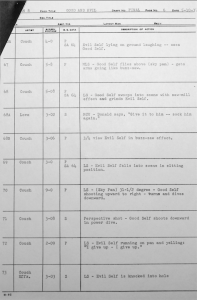
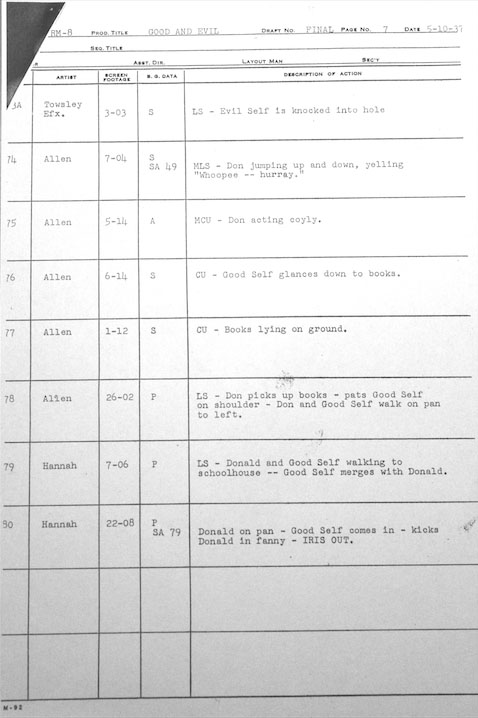
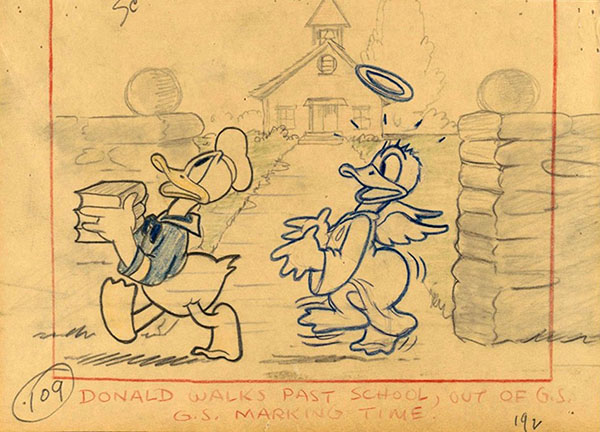
(Thanks to J.B. Kaufman, Michael Barrier, Keith Scott and Dave Gerstein for their help.)


 DEVON BAXTER is a film restoration artist, video editor, and animation researcher/writer currently residing in Pennsylvania. He also hosts a
DEVON BAXTER is a film restoration artist, video editor, and animation researcher/writer currently residing in Pennsylvania. He also hosts a 





















































































Parts of this cartoon were remade for the WWII cartoon “Donald’s Decision.”
The ending, in which Donald tries in vain to walk past the school, indicates his evil self isn’t quite dead.
Ex-Fleischer animator Berny Wolf predicted Walt’s demise in a subtle way.
We’ll never have a uncensored Disney treasures set ever again.
It’s interesting that Frank Tashlin used the same plot point of the school-age starring character being baited into smoking for his 1938 cartoon, “Wholly Smoke”, which was one of the last ones he did before leaving Warners for Disney (where the Warners effort for once has the more straightforward, less cynical ending than the Disney version, though in both cases, the ending fits the characters’ personalities).